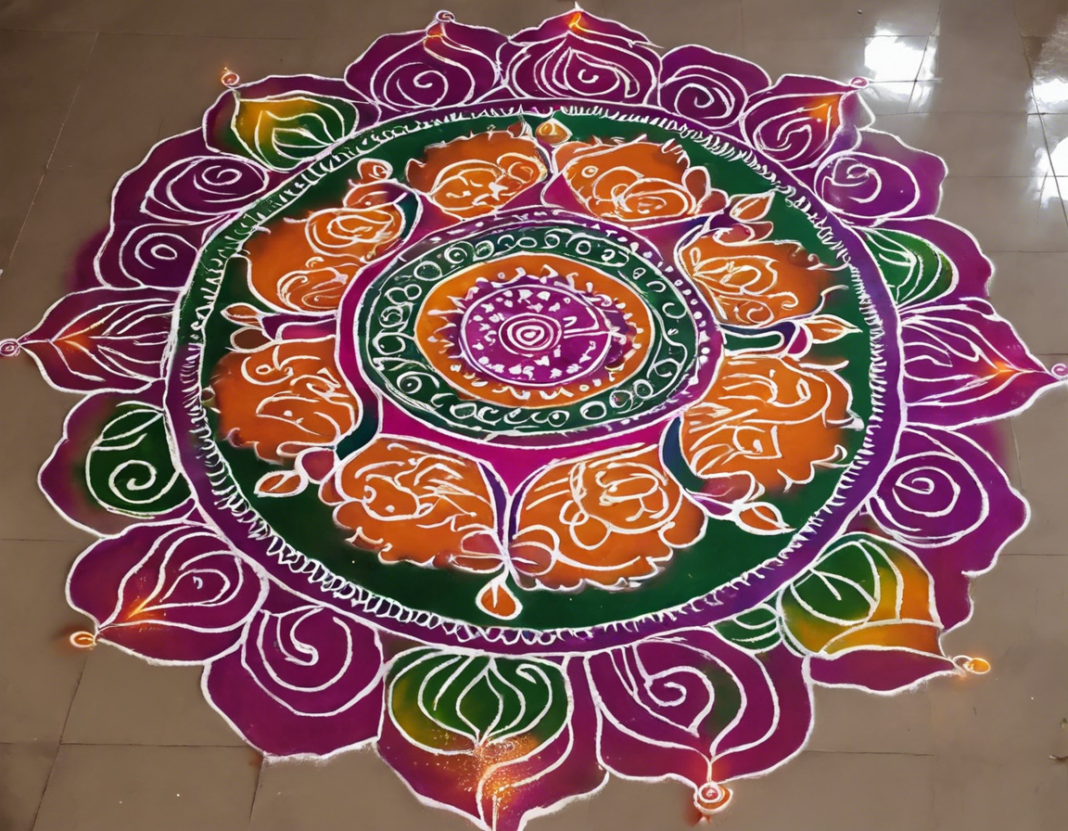Diwali, the festival of lights, is a time for joy, celebration, and spreading positivity. One of the most iconic traditions of Diwali is creating beautiful rangoli designs at the entrance of homes. Rangoli, also known as Kolam in the southern parts of India, is a decorative art form where patterns are created on the floor using materials such as colored rice, dry flour, colored sand, or flower petals.
These intricate rangoli designs not only add an aesthetic appeal to your home but also symbolize auspiciousness and good luck. If you’re looking to create something special for this Diwali, here are 10 creative Diwali rangoli designs that will surely make your home stand out:
1. Peacock Rangoli:
- Use vibrant colored powders to create a peacock design, symbolizing grace and beauty.
- Start with a circular base and add intricate details to form the peacock’s feathers and body.
2. Floral Rangoli:
- Opt for a floral theme with different flower patterns like lotus, roses, and marigold.
- Mix and match colors to create a visually appealing design.
3. Diya Rangoli:
- Create a rangoli design with multiple diyas (clay oil lamps) incorporated into the pattern.
- This design symbolizes the essence of Diwali – the victory of light over darkness.
4. Ganesha Rangoli:
- Outline the shape of Lord Ganesha and fill it with vibrant colors.
- Lord Ganesha is the remover of obstacles and is considered auspicious for new beginnings.
5. Traditional Rangoli:
- Go for a traditional design with intricate patterns like dots, lines, and geometrical shapes.
- Use contrasting colors to make the design visually striking.
6. Alpana Rangoli:
- Alpana is a Bengali style of rangoli that features freehand patterns inspired by nature.
- Create motifs like fish, flowers, and birds using white rangoli powder on a dark background.
7. Lamp Rangoli:
- Arrange diyas in a circular or floral pattern and surround them with colorful rangoli to enhance the look.
- This design is simple yet elegant and radiates the festive spirit of Diwali.
8. Swastika Rangoli:
- The Swastika is a sacred symbol in Hinduism symbolizing good fortune and well-being.
- Incorporate the Swastika symbol into your rangoli design for positive energy.
9. Paisley Rangoli:
- Use the paisley motif, also known as the mango design, to create a unique and intricate rangoli pattern.
- Add layers and details to make the design more appealing.
10. Abstract Rangoli:
- Let your creativity flow and create an abstract rangoli design with geometric shapes and patterns.
- Play with colors and patterns to craft a one-of-a-kind rangoli that reflects your style.
Whether you’re a beginner or an experienced rangoli artist, these Diwali rangoli designs offer a range of options to suit your skill level and preferences. Remember to start with a clean surface, use stencils or outlines for intricate designs, and add diyas or flower petals for a finishing touch.
Frequently Asked Questions (FAQs):
- What materials can I use to create a rangoli design?
-
You can use colored powders, rice flour, rangoli stencils, flower petals, colored sand, and diyas to create rangoli designs.
-
How long does a rangoli design typically last?
-
Rangoli designs made with dry materials like colored powders can last for a few days, while designs made with fresh flowers may last only a day.
-
Can children participate in creating rangoli designs?
-
Yes, children can participate in creating rangoli designs under adult supervision. It’s a fun and creative activity for the whole family.
-
Are there any specific auspicious symbols I should include in my Diwali rangoli?
-
Symbols like diyas, Swastika, lotus, Om, and Ganesha are considered auspicious and are commonly included in Diwali rangoli designs.
-
How can I preserve a rangoli design to make it last longer?
-
You can spray the design with a fixative like hair spray to help preserve it for a longer duration.
-
Can I create a rangoli design on a rough or uneven surface?
-
It’s best to create rangoli designs on a smooth and clean surface to ensure the patterns come out neat and well-defined.
-
What is the significance of rangoli in Indian culture?
-
Rangoli is considered a form of welcoming prosperity and good luck into homes. It is also believed to ward off evil spirits.
-
Are there online tutorials available for learning rangoli designs?
-
Yes, there are plenty of online resources like videos, step-by-step guides, and tutorials that can help you learn different rangoli designs.
-
Can I create a rangoli design indoors?
-
Yes, you can create rangoli designs indoors using materials like colored powders, flower petals, and colored sand in a designated area.
-
What is the best way to practice creating rangoli designs for beginners?
- Beginners can start by practicing simple designs with fewer elements and gradually progress to more complex patterns. Using stencils or templates can also be helpful for practicing intricate designs.









